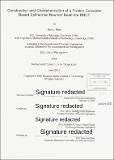Construction and characterization of a fission converter based epithermal neutron beam for BNCT
Author(s)
Riley, Kent J.(Kent Jason)
Download49725089-MIT.pdf (166.7Mb)
Other Contributors
Massachusetts Institute of Technology. Department of Nuclear Engineering.
Advisor
Otto K. Harling.
Terms of use
Metadata
Show full item recordAbstract
This study demonstrates the first successful implementation of a fission converter to produce a source of epithermal neutrons suitable for BNCT. The final design, construction and characterization of a new epithermal neutron beam is presented. A high intensity source with low contamination is obtained using a fission converter driven by thermal neutrons from the MIT research reactor. The facility is housed in the experimental hall and operates in parallel with other user applications. The fission converter is powered by 10 spent MITR-II fuel elements and employs resonance scattering filters with thermal neutron absorbers to tailor the neutron energy distribution. A lead shield attenuates photon contamination in the beam and lead collimators direct the neutron beam toward the patient. A horizontal beamline leads to the new medical room which is built with 1.1 m thick, high density concrete walls and is large enough to permit various treatment configurations. Ambient dose equivalent rates outside the shielded room are < I mrem/hr with the converter operating at full power and do not interfere with other experimental users and reactor operations. (cont.) Beam delivery is controlled with three in-line shutters that allow unrestricted access to the medical room while the reactor is at full power. Patient irradiations are controlled by redundant programmable logic controllers that automatically close the beam shutters when the prescribed monitor counts have been accumulated. Measurements were performed on central axis to assess beam performance. An in-air epithermal neutron flux of 8.4 +/- 0.8 E+09 n/cm2s was obtained with concomitant fast neutron and photon absorbed dose rates of 3.9 +/- 0.5 and 11.8 +/- 0.8 cGy/min. Depth dose profiles measured in-phantom are in general agreement with those determined from Monte Carlo calculations and indicate that normal tissue tolerance can be reached in treatment times of less than 10 minutes. The in-beam fast neutron and photon contaminants account for less than 10% of the dose received by normal tissue surrounding the target volume, which approaches the clinical optimum.
Description
Thesis (Ph. D.)--Massachusetts Institute of Technology, Dept. of Nuclear Engineering, 2001. Includes bibliographical references.
Date issued
2001Department
Massachusetts Institute of Technology. Department of Nuclear Engineering; Massachusetts Institute of Technology. Department of Nuclear Science and EngineeringPublisher
Massachusetts Institute of Technology
Keywords
Nuclear Engineering.